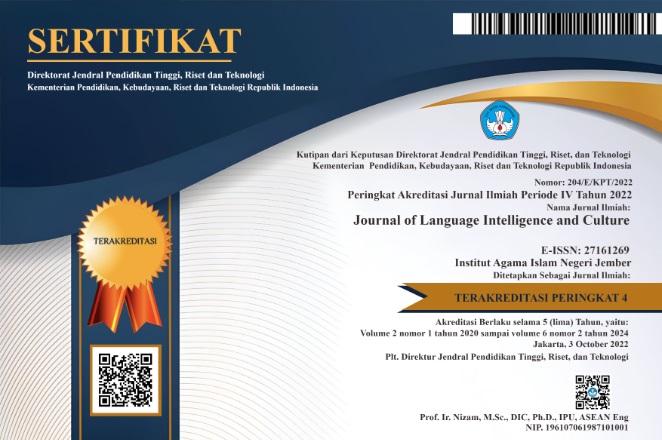Word Formation Analysis of Foreign Terms in Information and Communication Technology Based on General Guidelines of Formation Terms in Indonesia
DOI:
https://doi.org/10.35719/jlic.v5i2.116Keywords:
Foreign terms, formation terms, Information and Communication Technology (ICT), general guidelines for the formation termsAbstract
This research analyzes foreign terms in Information and Communication Technology (ICT) based on general guidelines for the Indonesian formation of terms (Pedoman Umum Pembentukan Istilah or PUPI). This research is descriptive qualitative. The analysis shows that Based on the General Guidelines for the Formation of Terms, the process of absorbing foreign terms in ICT into Indonesian can be classified into four processes, namely complete absorption, absorption through translation, absorption through adjustment of the form of writing, also absorption through adjustments to the form of writing and translation at the same time. While, the translation process by adjusting the form of writing is grouped into three forms of adjustment, namely spelling adjustment, adjustment of foreign consonant groups, and adjustment of foreign prefixes. In forming Indonesian computer terms, a collection of benchmarks and suggestions in General Guidelines for Enhanced Indonesian Spelling and General Guidelines. The emergence of ICT terms due to the advancement of science and technology can encourage Indonesians to adopt and form Indonesianized terms. Given the importance of the role of foreign terms in ICT as a ‘vehicle’ for the implementation of globalized international communication, ease of speed of mutual understanding between nations receives special attention from Indonesian computer terminology.
References
Badudu, Y. (1991). Inilah Bahasa Indonesia yang Benar. Gramedia.
Billups, F. D. (2019). Qualitative Data Collection Tools: Design, Development, and Applications. SAGE Publications.
Darheni, N. (2009). Penyerapan Leksikon Asing dalam Bidang Otomotif ke dalam Bahasa Indonesia: Tinjauan Secara Morfologis dan Fonologis. Jurnal Sosioteknologi, 8(17), Article 17.
Erlinawati, M., & Nurcholis, A. (2020). Implementasi Pembakuan Peristilahan Perkomputeran Dalam Bahasa Indonesia Untuk Mahasiswa SI 18A4 FIKOM Universitas Duta Bangsa Surakarta. Syntax Literate?; Jurnal Ilmiah Indonesia, 5(2), 92–99. https://doi.org/10.36418/syntax-literate.v5i1.927
Fitria, T. N. (2021). Word formation process of terms in COVID-19 pandemic. Leksika: Jurnal Bahasa, Sastra Dan Pengajarannya, 15(1), Article 1. https://doi.org/10.30595/lks.v15i1.9248
Fitria, T. N. (2023). Lexical Meaning of Medical Terms Found in English Book End of Days: Predictions and Prophecies about the End of the World. Vivid: Journal of Language and Literature, 12(2), 153–162. https://doi.org/10.25077/vj.12.2.153-162.2023
Hadi, S. (2017). Pembentukan Kata dan Istilah Baru dalam Bahasa Arab Modern. Arabiyat?: Jurnal Pendidikan Bahasa Arab dan Kebahasaaraban, 4(2), Article 2. https://doi.org/10.15408/a.v4i2.5801
Hesse-Biber, S. N. (2016). The Practice of Qualitative Research: Engaging Students in the Research Process. SAGE Publications.
Kukulska-Hulme, A. (1999). Language and Communication: Essential Concepts for User Interface and Documentation Design. Oxford University Press.
Maemunah, E. (2015, August 3). Padanan Istilah Komputer dalam Bahasa Indonesia. BALAI BAHASA PROVINSI JAWA TENGAH. https://balaibahasajateng.kemdikbud.go.id/2015/08/padanan-istilah-komputer-dalam-bahasa-indonesia/
Maryani, Z. (2017). Padanan Kata Asing-Indonesia Dalam Bidang Seni (Vol. 1). BP ISI Yogyakarta. http://lib.isi.ac.id
Megawati, B. (2019). Perkembangan Padanan Istilah Bahasa Asing Dalam Bahasa Indonesia Akibat Perkembangan Ipteks. INA-Rxiv. https://doi.org/10.31227/osf.io/58rk9
Miftahuddin, A. (2015). Pembentukan Kata dan Istilah dalam Bidang Hubungan Internasional pada Bahasa Arab: Tinjauan Semantis dan Morfologis. Al-Ma‘rifah, 12(2), Article 2. https://doi.org/10.21009/almakrifah.12.02.02
Miles, M. B., Huberman, A. M., & Saldana, J. (2018). Qualitative Data Analysis: A Methods Sourcebook. SAGE Publications.
Moeliono, A. M., Lapoliwa, H., Alwi, H., & Dardjowidjojo, S. (1998). Tata Bahasa Baku: Bahasa Indonesia. Department Pendidikan dan Kebudayaan.
Nuryanto, H. (2012). Sejarah Perkembangan Teknologi Informasi dan Komunikasi. PT Balai Pustaka (Persero).
Rahayu, M., & Aminudin, A. (2013). Kajian Kebahasaan Terhadap Peristilahan Internet. EPIGRAM, 10(1), Article 1. https://doi.org/10.32722/epi.v10i1.552
Rasjidi, I. T. (2015). Penyerapan Istilah Asing Pada Terminologi Hukum di Indonesia. LITIGASI, 16(2), Article 2. https://doi.org/10.23969/litigasi.v16i2.37
Rizqi, F. R. (2008). Penyerapan Istilah Asing Register Kedokteran Pada Rubrik Kesehatan Surat Kabar Republika Edisi Januari–Maret 2008 [Undergraduate Paper, Universitas Muhammadiyah Surakarta]. http://eprints.ums.ac.id/1155/
Said, M., & Puspitasari, R. (2009). Model Penyerapan Istilah Manajemen Bisnis (Sebuah Pemerkayaan Istilah Bahasa Indonesia Dari Bahasa Inggris) [Undergraduate Paper, Universitas Gunadarma]. http://repository.gunadarma.ac.id/375/
Saptiawan, I. H. (2015). Kajian Teks Kendala Penggunaan Istilah Teknologi Informasi Berbahasa Indonesia dan Relevansinya dengan Pembelajaran Bahasa di Sekolah Menengah Atas [Undergraduate Paper, Universitas Mataram]. http://eprints.unram.ac.id/8459/
Titi, R. (2010). Proses Pembentukan Kata Pada Istilah Berbahasa Inggris di Bidang Pariwisata (studi kasus majalah Destin Asian) [Undergraduate Paper, Universitas Diponegoro]. http://eprints.undip.ac.id/21928/
Wismanto, A. (2017). Interdependensi Antara Bahasa Indonesia Dengan Iptek Sebagai Penghela Pembentukan Istilah Melalui Media Bahasa. Jurnal Tuturan, 3(1), Article 1. https://doi.org/10.33603/jt.v3i1.812
Downloads
Published
How to Cite
Issue
Section
License
Copyright (c) 2023 Tira Nur Fitria

This work is licensed under a Creative Commons Attribution-ShareAlike 4.0 International License.












